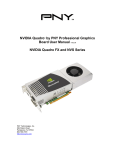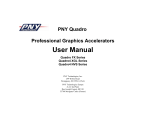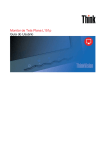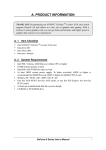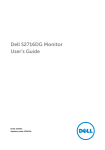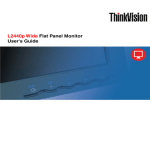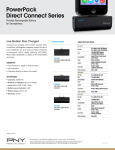Download NVIDIA© Quadro© and NVIDIA© NVS© by PNY
Transcript
NVIDIA Quadro and NVIDIA NVS by PNY Professional Graphics Board User Manual Jun_12 © © © © NVIDIA Quadro, Quadro NVS, and NVS Series PNY Technologies, Inc. 100 Jefferson Road Parsippany, NJ 07054-0128 800.769.7079 http://www.pny.com © Table of Contents Introduction 3 Minimum System Requirements 3 Package Contents 3 Hardware Installation 4 Additional Power Requirements 5 Attaching Displays 6 NVIDIA Graphics Driver Installation 6 NVIDIA NVIEW Installation 7 NVIDIA Control Panel 7 Technical Support 13 PNY’s Replacement Warranty 13 FCC Information 13 Limited Liability The information contained in this manual has been validated at the time of manual production. The manufacturer reserves the right to make any changes, additions and revisions to the product described in this manual at any time and without notice. Consequently, PNY Technologies, Inc. assumes no liability for damages incurred directly or indirectly from errors, omissions or discrepancies between the product and the manual. Copyright © 2012 by PNY Technologies, Inc. All rights reserved. No reproduction of this document in any form is permitted without prior written authorization from PNY Technologies, Inc. All registered trademarks are the property of their respective owners. -2- Introduction Congratulations on the purchase of your NVIDIA Quadro, Quadro NVS, or NVS by PNY professional graphics board. You are now the owner of a state-of-the-art graphics board specifically designed for demanding 3D or video applications, offering features and functionality beyond any other cards in their class. We recommend that you read through this User Guide before installing your graphics board to ensure proper operation. Minimum System Requirements ▪ PCI Express x16 slot for x16 PCIe boards or an x1 PCI Express slot for x1 PCIe boards ▪ Windows® 7 (any Edition), Vista (any edition), XP SP3, Linux® or Solaris® ▪ 1GB or more of system memory, 2GB recommended ▪ 200MB of available disk space for full installation ▪ Blu-ray, DVD-ROM or CD-ROM drive ▪ DisplayPort, DVI or VGA compatible display(s) Package Contents Please check your package, which should contain the items listed below. If you find any damaged or missing items please contact your supplier ▪ NVIDIA Quadro, Quadro NVS or NVS professional graphics board ▪ DVI-I to VGA adapter(s) – one per DVI-I connector (Quadro, Quadro NVS or NVS series) ▪ DisplayPort to DVI single-link adapter – one provided with any Quadro series card that features DisplayPort connectors ▪ DisplayPort to DVI single-link adapters – two provided with selected Quadro NVS 295 and NVS 310 part numbers ▪ DisplayPort to DVI single-link adapters – four provided with selected Quadro NVS 450 part numbers ▪ VHDCI to quad DVI single- link adapter provided with select Quadro NVS 420 part numbers ▪ VHDCI to quad DisplayPort adapter provided with select Quadro NVS 420 part numbers ▪ DMS-59 to dual DVI-I adapter cable provided with select NVS 300 part numbers ▪ DMS-59 to dual DisplayPort adapter cable provided with select NVS 300 part numbers ▪ Stereo I/O Bracket (3-Pin mini-DIN connector) included with Quadro 4000 ▪ SPDIF audio interface cable provided with Quadro NVS 295 ▪ Auxiliary power connector cable(s) – provided with any Quadro board requiring them ▪ CD-ROM with driver software for Windows 7, Vista or XP (any edition, 64- or 32-bit) -3- Hardware Installation Follow the steps listed in the order given to successfully install your new NVIDIA Quadro, Quadro NVS, or NVS by PNY professional graphics board. Important Static electricity can severely damage electronic components. Please take the following precautions when installing your new graphics board: ▪ Before touching any electronic parts, discharge the static electricity from your body by touching the internal metal frame of your computer while it is unplugged ▪ Don’t remove your card from the packaging clamshell until you are ready to install it. Whenever you remove a card from your computer, always place it back in clamshell ▪ Never let your clothing touch any electronic parts ▪ When handling a card, hold it by its edges, and avoid touching any circuitry Selecting the Correct Expansion Slot PCI Express based computers have a combination of PCI Express and PCI slots. Slots may look similar at first; however you will notice differences once you examine them more closely. The PCI Express x16 slot on your motherboard is usually the closest connector to the CPU. PCIE x1 slots are smaller and should be labeled as such. If you are unsure which connectors are PCI Express x16 or x1 consult your system manual to identify the appropriate slot. Plugging a graphics card into the incorrect slot could damage the card, your system, or both. Never force a card into a slot that does not easily accommodate it. Typical motherboard showing PCIE x16 and PCI slots Low Profile or Standard Height Bracket The Quadro 400, 410, and 600 are designed for SFF (Small Form Factor) systems; consequently a low profile bracket is attached. If your system requires a full height bracket one has been provided. Simply replace the low profile bracket with the standard height bracket and proceed with hardware installation. Quadro NVS low profile boards (Quadro NVS 295, Quadro NVS 420, NVS 300, and NVS 310) have full height brackets attached, but a low profile bracket is provided for SFF systems. If necessary replace the standard height bracket with the low profile bracket and proceed with hardware installation. -4- Inserting Your Graphics Card Remove the backplane cover for the slot you intend to use and save the mounting bracket screw. Position the graphics board over the expansion slot that coincides with the type (PCI Express x16 or x1) of the card purchased. Push the card firmly and evenly until it’s fully seated in the slot. Replace the screw to secure the bracket of the graphics card to the computer chassis. Replace the cover of your computer. Attach any DisplayPort, DVI-I, or VGA compliant monitor cable(s) to the appropriate connectors on your graphics board. All cables must be connected before your computer is powered on. Additional Power Requirements Quadro 6000, Quadro 5000, and Quadro 4000 In order for the NVIDIA Quadro by PNY graphics boards noted above to operate correctly, the auxiliary power connector cable(s) which are supplied as required must be installed. These ‘Y’ cables have two 4-pin connectors that attach to power supply taps and a 6-pin connector that plugs into a matching receptacle on your graphics board. Connectors for auxiliary power cables are keyed. Always verify the orientation of cable and connector and never force the cable into the connector. A representative Quadro graphics board with two auxiliary power connector cables plugged into card, loose ends must be plugged into available power supply taps Quadro 6000 Auxiliary Power Requirements Quadro 6000 graphics boards have two auxiliary power connectors, one 8-pin connector and one 6-pin connector. The 8-pin connector will drive your Quadro 6000 when connected to the dedicated graphics 8pin connector tap provided by PCIE Gen 2 compliant power supplies. Older systems must use two 6-pin auxiliary power connector cables (provided) for proper operation. This requires that four power supply taps be available. One 6-pin cable connects to the 8-pin connector (parts are keyed to ensure proper connection) and the second 6-pin connector plugs into the remaining 6-pin connector. PNY strongly recommends the use of a PCIE Gen 2 compliant power supply with the Quadro 6000. Connecting the SPDIF Audio Cable An 18” SPDIF audio interface cable is provided with the Quadro NVS 295 professional graphics board. This cable allows content with an audio signal, such as Blu-ray or DVD to be passed from the motherboard for further processing and signal conversion. One end of the cable connects to the two-pin connector on the graphics board while the other needs to be attached to the SPDIF motherboard connector. Consult the documentation that came with your system for additional information on this topic. -5- Attaching Displays Quadro 6000, Quadro 5000, Quadro 4000, and Quadro 2000 These boards have a single DVI dual-link connector and two DisplayPort connectors. Although this gives a total of three output connectors only two can be used at the same time. Quadro 2000D This board features two DVI dual-link connectors. Analog displays are supported via the supplied DVI to VGA adapters. Quadro 600, Quadro 410, and Quadro 400 These boards feature a DVI dual-link connector and a DisplayPort connector. An analog display is supported via the supplied DVI to VGA adapter. Quadro NVS 450 x16 This board features four DisplayPort connectors, which support any DisplayPort monitor. Some NVS 450 are sold with four DisplayPort to DVI single-link adapters. To connect DVI single-link displays to the NVS 450 plug in the supplied adapters and then attach your display(s) to the DVI connectors provided. Quadro NVS 420 x16 or NVS 420 x1 These low profile boards utilize VHDCI connectors. Depending on which configuration you purchased either a VHDCI to quad DVI single-link or VHDCI to quad DisplayPort adapter cable is included. Connect the VHDCI adapter cable to the VHDCI connector on your NVS 420 and then connect your display(s) cable(s) to the DVI or DisplayPort connectors provided, starting with the lowest number first (numbered from 1 – 4). NVS 310, Quadro NVS 295 x16, and Quadro NVS 295 x1 These boards feature two DisplayPort connectors which support any DisplayPort monitor. Some models include two DisplayPort to DVI-D single-link adapters. If you utilize DVI displays connect the DisplayPort to DVI-D single-link adapters and then connect your display cables to the adapters. NVIDIA NVS 300 x16 or NVS 300 x1 These boards feature a single DMS-59 connector and ship with either a DMS-59 to dual DVI single-link ‘Y’ adapter cable and two DVI to VGA or a DMS-59 to dual DisplayPort adapter cable. Plug the provided adapter into the DMS-59 connector on the graphics board and then connect your display cables to the connectors on the adapter. NVIDIA Quadro or NVS Graphics Driver Installation (Windows) Power up your system and let it boot into Windows 7, Vista or XP. Logon and proceed as noted below: ▪ Insert the NVIDIA Quadro by PNY driver installation CD into the Blu-ray, DVD-ROM or CD-ROM drive. The CD will auto run and you will be presented with a main menu that includes driver installation, along with other options. ▪ From the main menu click on the ‘Drivers’ option and the proper driver for your version of Windows 7, Vista or XP will be presented (64- or 32-bit versions are provided). Click on the driver presented to confirm your choice and the software will automatically be installed NVIDIA Quadro or NVS Graphics Driver Installation (Linux) Power up your system and let it boot into Linux. Logon and proceed as noted below: ▪ Download the Linux driver appropriate to your Quadro board and Linux distribution from the Internet. Drivers can be downloaded from the PNY or NVIDIA websites. The PNY driver download page URL is: -6- http://www3.pny.com/support/support_landing_subcat.aspx?SectionID=1090&RootSectionID=1061&Ty peID=5 ▪ Install the driver as described by your Linux distribution documentation or via the script provided with the driver download NVIDIA NVIEW Installation NVIEW is a desktop utility that simplifies multiple display management and enhances your desktop. After installing your graphics drivers and rebooting your system, the NVIDIA NVIEW wizard will appear. You can choose to install NVIEW (highly recommended) or cancel NVIEW setup. Each screen presented by the setup wizard will give you a brief description of the options NVIEW will enable. Detailed NVIEW documentation is available on your driver CD. NVIDIA Mosaic Technology Mosaic Technology enables seamless taskbar spanning as well as transparent scaling of any application across up to 8 displays using multiple Quadro, Quadro NVS, or NVS series graphics cards (Windows 7 only). NVIDIA Control Panel The NVIDIA Control Panel (available after driver installation) allows you to access and configure all of the features offered by your Quadro, Quadro NVS or NVS series professional graphics card. From changing screen resolution and other image settings, to selecting optimum performance options for your professional 3d applications, to tailoring productivity enhancements such as NVIEW, or working with expansive ultra-high resolution or multiple display systems with NVIDIA Mosaic Technology, the NVIDIA Control Panel provides direct features to the powerful hardware and software capabilities of your new graphics board. Because of the many features offered the remainder of this User Manual largely focuses on accessing and configuring the NVIDIA Control Panel. To launch the NVIDIA Control Panel right-click the Windows desktop and select “NVIDIA Control Panel. You will be presented with the screen shown below in Figure 1 (All screen shots from Windows 7). Figure 1 – 3D Settings: Adjust image settings with preview -7- ▪ These settings allow you to adjust you card for either performance or quality – options include ‘Let the 3D application decide’, ‘Use the advanced 3D image settings’ or ‘Use my preference emphasizing: Quality – a preview option provides interactive visual feedback if you elect to adjust these settings with the slider control Figure 2 – Manage 3D Settings ▪ The listbox contains all of the features you can adjust on your NVIDIA Quadro by PNY graphics board – you can change the setting of a feature using the dropdown listbox beside the feature name. If in doubt about a particular feature the ‘Application-controlled’ setting is your best option. Figure 3 – Change Resolution -8- ▪ Use this option to set the display resolution (in pixels), select a Color quality setting (32-bit recommended) and adjust the refresh rate of your display. Settings can be specified for each display attached to your graphics board. Figure 4 – Change Flat Panel Scaling ▪ If you elect to use resolution on your flat panel display other than the display’s native resolution this setting will allows you specify the scaling used in order to achieve the highest possible display quality – but please note that flat panel displays always look best when run at native resolution Figure 5 – Adjust Desktop Color Settings -9- ▪ Allows you to adjust the color settings for your desktop – these changes will not affect any video playback – to change video color settings, go to ‘Adjust Video Color Settings’ Figure 6 – Rotate Display ▪ NVIDIA NVRotate allows you to change the orientation of your desktop, this is useful if you have rotated your physical display and need to rotate the desktop to match the orientation of your display – options include ‘No rotation (Landscape’, ’90 degrees to the left (Portrait’, 90 degrees to the right (Inverted portrait)’, and ‘180 degree rotation (Inverted landscape)’. - 10 - Figure 7 – Manage Custom Resolutions ▪ Manage Custom Resolution’s allows you to select and utilize, with the highest possible performance and visual display quality, any custom (non-standard) resolutions supported by any display attached to your NVIDIA Quadro by PNY graphics board Figure 8 – Set up Multiple Displays ▪ Set up Multiple Displays allows you to set optimal parameters for each display, gives you full control over features such as horizontal or vertical monitor spanning, and allows you to position the displays relative to one another based on where they are physically located Figure 9 – Adjust Video Color Settings - 11 - ▪ Adjusting the video color settings allows you to fine tune the color settings for video content on your display – for best results, play a video while you make adjustments to view the changes as they happen Figure 10 – 3D Stereo Settings ▪ Enables the viewing of stereoscopic 3D images generated by many scientific/technical or visualization solutions and some Digital Content Creation (DCC) applications. - 12 - For additional information on configuring your NVIDIA Quadro by PNY professional graphics board driver software please refer to the Driver Release Notes provided on your driver CD. Technical Support PNY Technologies provides free and unlimited United States-based technical support for NVIDIA Quadro or NVIDIA NVS by PNY professional graphics boards 5 days a week, Monday to Friday, from 9:00 AM to 7:00 PM Eastern Time. For technical support call PNY Technologies at 800.230.0130 or email [email protected]. Registering your board with PNY will ensure access to this valuable service. PNY’s Replacement Warranty PNY Technologies, Inc. warrants your NVIDIA Quadro or NVIDIA NVS by PNY professional graphics board to be free from defects in materials and workmanship for a period of three years from the date of purchase (For additional information visit http://www.pny.com/support/register/warr2.asp.) of the product as sold to the original purchaser, subject to all the terms and conditions hereunder. This warranty is not assignable. PNY’s sole obligation under this warranty is to replace the product with like or similar product. This warranty applies only on the condition that the product has been installed, maintained and operated under conditions of normal use and in accordance with the installation guide provided herewith. The provisions of this warranty shall not apply if, in PNY’s judgment, the product has been subject to misuse or neglect, improper installation, damaged in an accident, or repaired or altered in any way that adversely affects its performance or reliability. THIS WARRANTY IS IN LIEU OF ANY OTHER WARRANTIES, EITHER EXPRESS OR IMPLIED, INCLUDING WITHOUT LIMITATION ANY WARRANTIES OF MERCHANTABILITY OR FITNESS FOR A PARTICULAR PURPOSE OR TITLE AGAINST INFRINGEMENT, WHICH OTHER WARRANTIES ARE EXPRESSLY EXCLUDED AND DISCLAIMED. PNY SHALL NOT BE LIABLE FOR LOSS OF PROFITS OR ANY SPECIAL, INCIDENTAL OR CONSEQUENTIAL DAMAGES WHICH PURCHASER MAY SUSTAIN, EVEN IF PNY HAS BEEN ADVISED OF THE POSSIBILITY OF SUCH LOSSES OR DAMAGES. IN NO EVENT SHALL PNY’S LIABILITY EXCEED THE PURCHASE PRICE OF THE DEFECTIVE PRODUCT. SOME STATES DO NOT ALLOW THE EXCLUSION OR LIMITATION OF INCIDENTAL OR CONSEQUENTIAL DAMAGES, SO THESE LIMITATIONS MAY NOT APPLY TO YOU. THIS WARRANTY GIVES YOU SPECIFIC LEGAL RIGHTS AND YOU MAY ALSO HAVE OTHER RIGHTS, WHICH VARY FROM STATE TO STATE. THIS WARRANTY SHALL NOT BE EXTENDED, ALTERED OR VARIED EXCEPT BY A WRITTEN INSTRUMENT DULY SIGNED BY PNY. Warranty coverage requires proof of purchase documentation evidencing the date of purchase (sales receipt or invoice). The information in this document is subject to change without notice. FCC Information This equipment has been tested and found to comply with the limits for a Class B digital device, pursuant to Part 15 of the FCC Rules. These limits are designed to provide reasonable protection against harmful interference in a residential installation. This equipment generates radio frequency energy, and if not installed and used in accordance with the instructions, may cause harmful interference to radio or television reception, which can be determined by turning the equipment off and on. The user is encouraged to try to correct the interference by one or more of the following measures: ▪ Reorient the receiving antenna ▪ Increase the separation between the equipment and receiver ▪ Connect the equipment to an outlet on a circuit different from that to which the receiver is connected ▪ Consult the dealer or an experienced radio or TV technician for additional help and assistance - 13 - This device complies with Part 15 of FCC Rules. Operation is subject to the following two conditions: (1) This device may not cause harmful interference and, (2) this device must accept any interference received, including interference that may cause undesired operation. Notice to user: Changes or modifications to this product not approved by the party responsible for FCC compliance could void your authority to operate this equipment. In order for an installation of this product to maintain compliance with the limits for a Class B device, shielded cables must be used for the connection of any devices external to this product. To the judgment of the products with regard to electromagnetic compatibility according following regulations: ▪ EN 50081-1 (EN55022 class B) ▪ EN 50082-1 (IEC 801 Part 2, 4 / ENV 50140 / ENV 50141) PNY Technologies 100 Jefferson Road • Parsippany, NJ 07054-0218 • 800.769.7079 • www.pny.com Copyright © 2012 by PNY Technologies, all rights reserved. No reproduction of this document in any form is permitted without prior written authorization from PNY Technologies, Inc. All registered trademarks are the property of their respective owners. - 14 -














